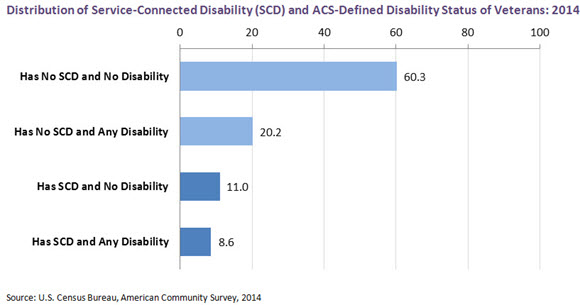Is a Veteran With a Service-Connected Disability the Same as a Disabled Veteran?
Is a Veteran With a Service-Connected Disability the Same as a Disabled Veteran?
The Census Bureau’s American Community Survey (ACS) provides a variety of information critical to understanding the needs of America’s veterans. This information is relied upon by the Department of Veterans Affairs (VA) to provide services to the 19 million veterans living in the U.S. and Puerto Rico. One topic of particular importance to VA and other veterans’ advocates is disability status.
There are several definitions that can be used to address issues facing America’s disabled veteran population. The ACS has included two distinct question series related to disability status since 2008 to provide key statistics for use primarily by VA.
The first question series measures functional disabilities and difficulties with activities of daily living among the general population. The second series measures VA service-connected disability status and ratings. A service-connected disability is a disability, disease or injury incurred or aggravated during active military service. The degree of disability is graduated from 0 percent to 100 percent in increments of 10 percent.
The combination of disability data with the detailed socioeconomic characteristics available from the ACS improves how VA measures the demand for health care services. ACS allows VA to cross-classify service-connected disability status with income to determine which veterans might qualify for priority health care enrollment. ACS also provides market-level statistics for VA to determine the location of health care facilities.
In 2014, about 28.8 percent of all veterans had any type of disability, as defined by the ACS, and 19.6 percent of all veterans (about 3.7 million) had a VA service-connected disability rating. Looking at the two concepts in conjunction, 8.6 percent of all veterans had both a service-connected disability and an ACS-defined disability. Eleven percent had a service-connected disability and no ACS-defined disability, while 20.2 percent had no service-connected disability but did have an ACS-defined disability (see figure below).
So, is a veteran with a service-connected disability the same as a “disabled” veteran?
Not necessarily. Veterans with a service-connected disability rating were more likely at all ages to have an ACS-defined disability than veterans without a service-connected disability rating. However, even those veterans with the highest ratings did not all report having an ACS-defined disability. About 35 percent of veterans with a service-connected disability rating between 0 and 40 percent, and 54.6 percent of veterans with ratings of 50 percent or higher had an ACS-defined disability. In this sense, having a service-connected disability rating does not equate to having a disability for these veterans.
The two measures of disability on the ACS are correlated but are not interchangeable. Therefore, it is important for data users to know how they want to define “disabled” when categorizing veterans. Questions about disability status generally measure prevalence of disability in the population. The series of six questions does not capture all types of disability or account for the severity of an individual’s impairment. It is also not possible to determine when a disability occurred, which is relevant to the discussion of service-connected disability status in the ACS. The concept of service-connected disability status generally measures participation in a benefits program administered by the VA.
Using data from the American Community Survey, the Census Bureau’s latest working paper on veterans, “The Disability of Veterans”, highlights the differences in the measurement of these disability concepts and further discusses the prevalence and types of disabilities among the veteran population.
For more information on veterans, visit the Census Bureau’s veterans statistics page.




